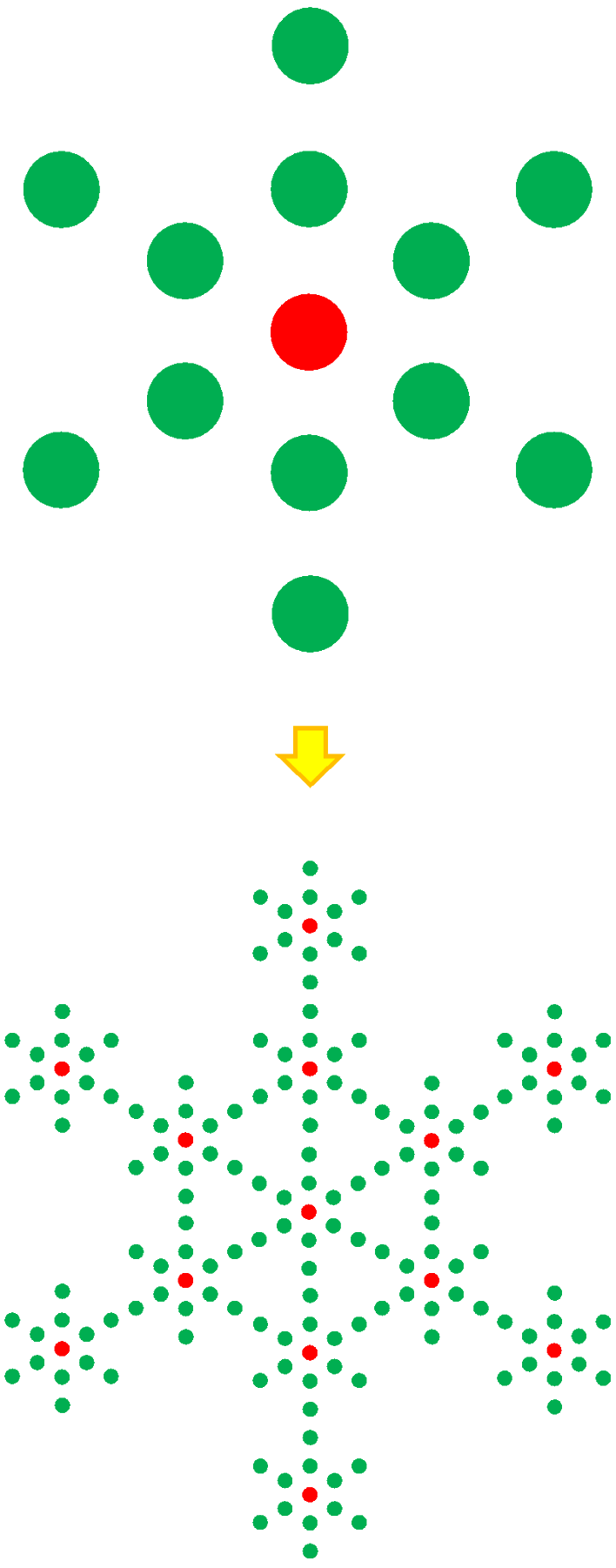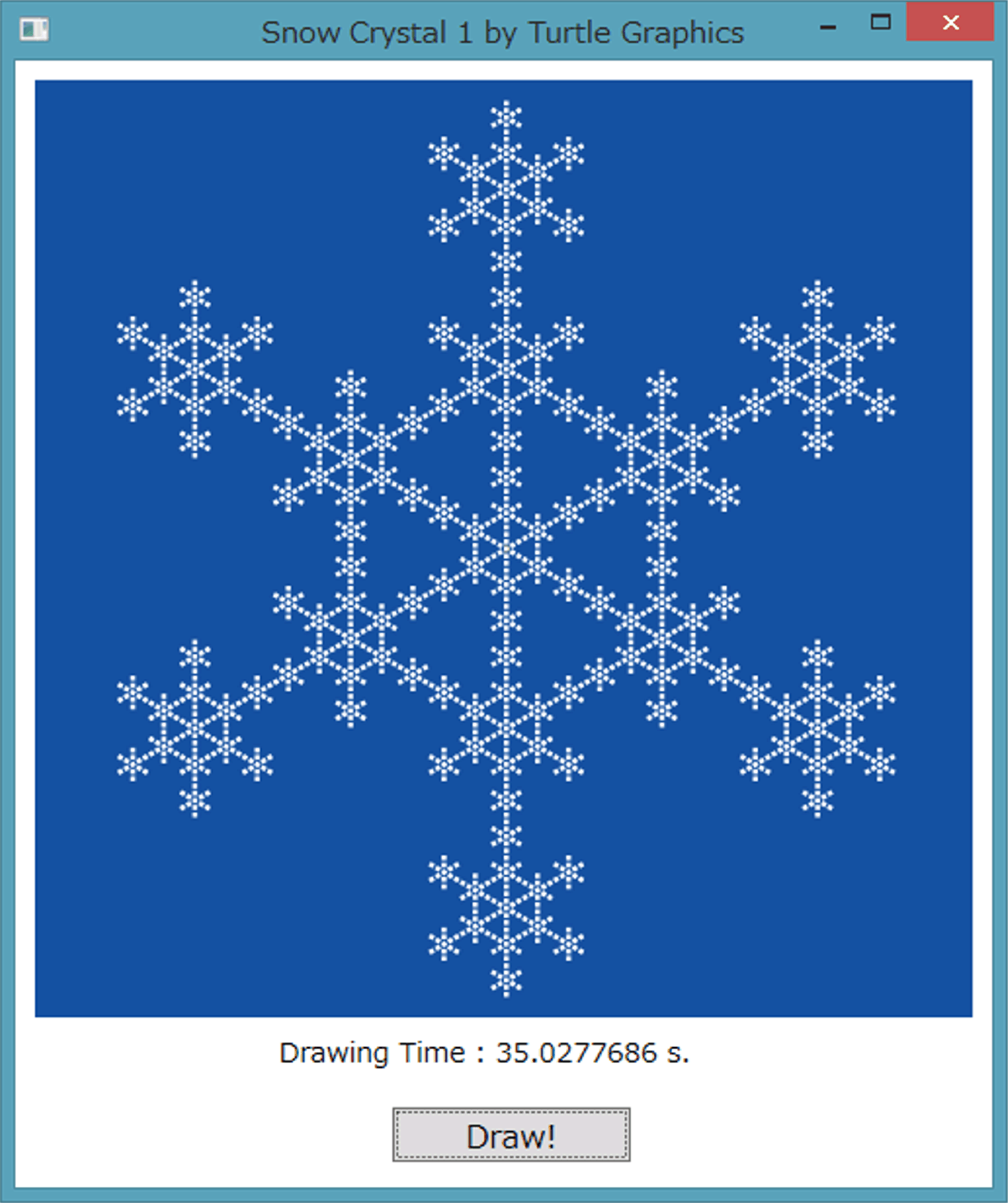Fractal: Snow Crystal
1 (WPF
with C#)
|
Applied rule of recursive
drawing
 |
 |
| This figure indicates an applied rule of recursive drawing. When the complexity order is increased, additional green points are generated around the previous green points. This rule are inherited for all the order. Here, the maximum complexity order is 3. |

| //
SnowCrystal1_WPF\MainWindow.xaml.cs // Snow Crystal 1 with Dots // (WPF application with C# // on Microsoft Visual Studio Express 2013 for Windows Desktop) // Dec. 13, 2014, by Masao Sakuraba // (Ref. 1-6 guided me to this program.) // * NOTE1: Blue-color parts were automatically generated by Visual Studio. // * NOTE2: Red-color parts were newly added. using System; using System.Collections.Generic; using System.Linq; using System.Text; using System.Threading.Tasks; using System.Windows; using System.Windows.Controls; using System.Windows.Data; using System.Windows.Documents; using System.Windows.Input; using System.Windows.Media; using System.Windows.Media.Imaging; using System.Windows.Navigation; using System.Windows.Shapes; using System.Diagnostics; // Namespace for class "Stopwatch". using ThinkLib; // After adding the file "ThinkLib.dll" as a reference [1,2]. namespace SnowCrystal1_WPF { /// <summary> /// MainWindow.xaml の相互作用ロジック /// </summary> public partial class MainWindow : Window { Turtle pen1; // Make a turtle using ThinkLib [3]. double PI = 3.141592654; double DotSize = 2.5; double Length = 230.0; int N_branch = 6; int N_repeat = 2; int Complexity = 3; void PatternGenerator1(Turtle _pen, double _length, int _complexity) { int i, j; if (_complexity == 0 | _length < 1.5) { _pen.BrushDown = false; _pen.Forward(-DotSize / 2); _pen.BrushDown = true; _pen.Forward(DotSize); _pen.BrushDown = false; _pen.Forward(-DotSize / 2); } else { for (i = 0; i < N_branch; i++) { if (i == 0) PatternGenerator1(_pen, _length / (2 * N_repeat + 1), _complexity - 1); // Recursion [4,5]. for (j = 1; j <= N_repeat; j++) { _pen.Forward(_length * 2 / (2 * N_repeat + 1)); PatternGenerator1(_pen, _length / (2 * N_repeat + 1), _complexity - 1); } _pen.Right(180.0); _pen.Forward(_length * 2 * N_repeat / (2 * N_repeat + 1)); _pen.Right(180.0); _pen.Right(360.0 / N_branch); } } } public MainWindow() { InitializeComponent(); pen1 = new Turtle(playground); // After making Canvas in MainWindow // with the Canvas name of "playground" [3]. pen1.Visible = false; // When you do not like showning a turtle [6]. pen1.Clear(); pen1.BrushWidth = DotSize; pen1.WarpTo(240, 240); pen1.LineBrush = Brushes.Orange; pen1.Forward(DotSize); pen1.BrushDown = false; pen1.Forward(-DotSize / 2); pen1.LineBrush = Brushes.White; pen1.Left(90); } private void Button1_Click(object sender, RoutedEventArgs e) { // After making Button for Event Handler. Stopwatch TimeMeasure = new Stopwatch(); // Make a stopwatch. TimeMeasure.Start(); PatternGenerator1(pen1, Length, Complexity); double Time_in_s = (TimeMeasure.Elapsed).TotalSeconds; Label1.Content = ("Drawing Time : " + Time_in_s + " s."); } } } |
Reference
(1)
"Think Sharply with C#" by Prof. Peter Wentworth (Rhodes Univ.),
http://www.ict.ru.ac.za/resources/ThinkSharply/thinksharply/
(2) "Appendices :
Getting Started with ThinkLib",
http://www.ict.ru.ac.za/Resources/ThinkSharply/ThinkSharply/thinklib_getting_started.html
(3) "Chapter 7
: Hello, little turtles!",
http://www.ict.ru.ac.za/Resources/ThinkSharply/ThinkSharply/hello_little_turtles.html
(4) "Chapter
21 : Recursion",
http://www.ict.ru.ac.za/Resources/ThinkSharply/ThinkSharply/recursion.html
(5)
「フラクタル紀行」、芹沢浩・著、森北出版株式会社、
http://www.morikita.co.jp/books/book/107
(6)
"Appendices : ThinkLib.Turtle Documentation",
http://www.ict.ru.ac.za/Resources/ThinkSharply/ThinkSharply/thinklib_turtle_docs.html
This home page is produced by KompoZer (free and open software).